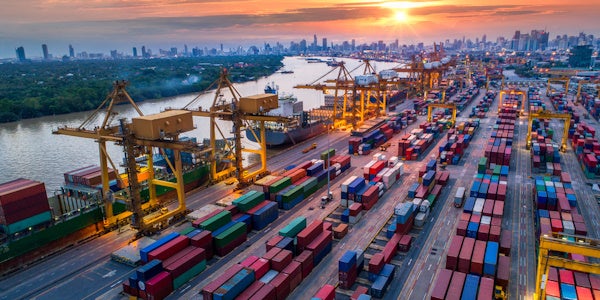Rewind the clock about 15 years, and you won’t likely hear many business leaders expounding on the benefits of supply chain transparency. Today, however, it’s top of mind. Many consumers are more focused than ever on company sustainability, and production transparency can be an essential part of meeting their demands.
But what full supply chain transparency looks like in practice is difficult to define. In the broadest sense, supply chain transparency encompasses the entire production process, from sourcing the raw ingredients for a product to its delivery to consumers. Many businesses have a degree of oversight, but full awareness takes concerted effort. For maximal transparency, companies must have access to supplier company practices and disclose their own.
While this sounds like tedious extra work, the costs of not operating a transparent business can be too great to ignore. Consumers, stakeholders, governments, and other organizations increasingly focus on sustainability concerns, such as conflict minerals, labor conditions, and environmental impact. They may demand full disclosure of company practices.
Providing unclear or inaccurate information can damage your reputation, cut into profits, and in some instances, even land your business in legal jeopardy.
Supply chain transparency is a key concern for most businesses navigating the modern era. It may be time to adopt transparency as a comprehensive value in your business approach. You might even benefit from the focus with reduced costs, increased efficiency, and an enhanced brand.

Supply Chains During and After the Pandemic: Accelerating Digital Transformation and Company Sustainability
The Covid-19 pandemic was a major shock to our just-in-time global supply chain system. We once applauded the highly specialized, interconnected network. But a worldwide crippling of international trade highlighted just how fragile this system was. We learned deviations in consumer habits or supply sourcing can cause the whole thing to come to a standstill.
On the consumer’s end, the pandemic-related shutdowns led to a rapid shift in buying habits. Trapped inside their homes, shoppers purchased goods at a much greater rate. Stimulus payments and other pandemic-era economic measures added fuel to the purchasing fire, keeping consumers afloat through the turmoil.
At the same time, however, businesses had trouble sourcing the materials to meet this uptick in demand. The same shutdowns that forced consumers inside crippled production around the world. Businesses couldn’t count on their usual suppliers—especially those halfway around the world.
A Shift to Nearshoring to Boost Sustainability
Many businesses chose suppliers because of cost. That often meant some raw materials and goods came from faraway locations and used cheap labor or non-sustainable practices that kept costs down.
But as this international network faced bottleneck after bottleneck, businesses began to re-examine their cost and risk policies and the weaknesses these breakdowns uncovered. They saw how critical sustainability was to running a resilient business and instead sought out suppliers closer to home, even if the cost of goods was greater. Businesses looked at not only where they obtained raw materials but the sourcing and labor practices that went along with them.
These changes were rooted in transparency. The rupture of the old system showed how essential traceability is to identify glitches before they affect the entire system. Businesses scrapped old supply chains and created new “future-proof” ones: new networks that centered on company sustainability and corporate responsibility.

The Sustainable Procurement Barometer 2021—a study conducted jointly by the Value Chain Innovation Initiative and EcoVadis—revealed that 73% of suppliers and 63% of buyers admitted that sustainable procurement practices are what helped them survive the pandemic. As businesses learned to cope with the pandemic, transparency improved internationally.
Traceability and Transparency: Improving Supply Chain Sustainability
Environmentally sustainable supply chain management depends greatly on a few key pillars:
- Corporate social responsibility
- Resource conservation
- Resource oversight
- Reduced carbon emissions
- Safe labor practices
Monitoring these key pillars requires comprehensive traceability and transparency over time. Making an effort to ensure transparency across the supply chain can help businesses maintain consistent sources of goods and a reliable network to obtain them.
Traceability encompasses the conditions of the products, materials, and raw resources along every step of production. A business should know where a product originated, the conditions in which it was procured or made, and where it is at any given point in the chain.
What’s more, traceability and transparency can directly influence consumer trust and company sustainability. Recalling and recovering potentially unsafe products shows corporate responsibility. So, providing continued product information becomes less of a marketing strategy and more of a trust-building exercise for consumers.
An accurate and current records trail can help you provide comprehensive traceability. This enables management to spot delayed materials in transit and quickly rectify the situation while assisting with recall management needs.
Speedy recall capabilities are vital should a problem manifest with a product, such as faulty parts or contamination. A fully traceable network lets you pull those items and quickly identify part or batch numbers for a consumer product recall.
As shown, the benefits of traceability and transparency can bolster your overall company sustainability efforts, so you can further optimize your business.
Let’s take a look at three key ways supply chain visibility can make it possible to boost your bottom line by tightening your operations.

1. Business Value and Operational Efficiency
Transparency and traceability can do more than simply ensure supply chain sustainability. When properly implemented, they can also improve operational efficiency and increase the value of your business. They may even expand your pool of business opportunities.
Future business success will hinge on a transparent, traceable, and circular supply chain. A supply chain that reduces waste, reuses materials, and recycles or remanufactures products can be key to lowering production costs. Traceability can reveal possible disruptions in these new, sustainable supply chains so companies can react in an agile manner to remedy them.
By analyzing supply chain data, companies can optimize their operations, make predictions about demand, and fill orders more efficiently. This newfound visibility could also help highlight opportunities for new markets or suppliers. Once your business has a command of the entire production process, you can optimize inefficiencies and fill the gaps with new opportunities. This has the potential to boost revenue twofold!
2. Demands From Stakeholders
Transparency and traceability unite all stakeholders in a common purpose, keeping producers and consumers informed along the product pipeline. Sustainability claims can be verified not only through labeling or certification but also with data derived from the company’s supply chain management system—data indicating environmentally sustainable considerations and equitable labor practices.
At a time when consumers are emphasizing responsible social practices in production, traceability is the key to monitoring the supply chain to help ensure you meet those demands. Transparent supply chain management systems can have the power to bolster your business’ reputation. As a result, you can market your role as a trustworthy, ethical enterprise—and back up the claim.
Winning consumers’ trust in this fashion can turn them into repeat customers and loyal promoters of your brand. Likewise, you can source more reliable business partners when you can prove that you mean what you say.
Traceability and transparency can also have a hand in stakeholders investing in and financing your operations. Consumers aren’t alone in demanding environmental consideration in business practices. Financiers want confirmation that their investment in your company can hold up resiliently in an unpredictable future. So, suppliers who are transparent about their sustainable practices may be more likely to secure business loans at more favorable rates.

3. Compliance With Existing Regulations and Guidelines
Both new and existing regulations and guidelines from federal and international organizations have put pressure on companies to adopt or strengthen their company sustainability efforts ASAP.
Changes in funding procedures are frequently impacted by environmental, social, and governance factors. The Securities and Exchange Commission (SEC) recently amended its rules and reporting forms in regard to environmental, social, and governance factors. These changes can require more specific disclosures. For example, a company looking for funding for a project with environmental elements might be required to provide greenhouse gas emission reports with its portfolio of investments.
Traceability and transparency can simplify compliance with new and changing regulations. Having supply chain data readily available can help ensure that you have all the information on hand for applications and reports.
Transparency for Future-Proofing Your Company Sustainability Efforts
Supply chain transparency can be vital for company sustainability in an unpredictable world. Recent world events showed how complex networks with little oversight or resiliency can quickly fall apart. No one knows what similar challenges may lie ahead in the coming decades, it’s prudent to be prepared nonetheless.
As a first step, consider getting a total understanding of your supply chain. After all, you can’t begin to fix a problem if you don’t intimately understand it. Transparency and traceability can help strengthen your existing supply chain management and aid in the shift toward more sustainable practices. To future-proof your business—and address turmoils in the present—consider investing in supply chain traceability and transparency solutions.
Making the requisite investments requires a forward-thinking strategy and financial planning. Reach out to start a conversation with one of the HTLF bankers at Arizona Bank & Trust, a division of HTLF Bank today and start planning your company’s future.

